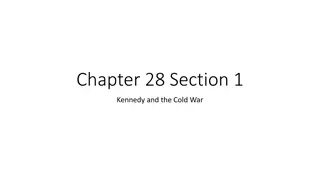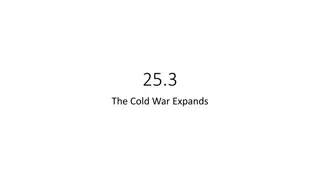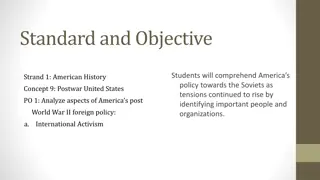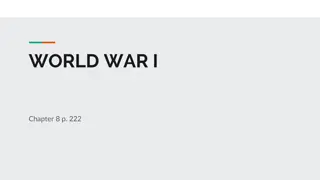Understanding Cold War Tensions: Causes, Events, and Decisions
Explore the complex dynamics of the Cold War era through a series of questions and analyses. Uncover the factors behind the hostile relations between the USA and the Soviet Union from 1945 to 1949, including the Berlin Blockade and key conferences like Yalta and Potsdam. Delve into the breakdown of alliances, conflicting policies, and tensions that defined this crucial period in history.
Download Presentation

Please find below an Image/Link to download the presentation.
The content on the website is provided AS IS for your information and personal use only. It may not be sold, licensed, or shared on other websites without obtaining consent from the author. Download presentation by click this link. If you encounter any issues during the download, it is possible that the publisher has removed the file from their server.
E N D
Presentation Transcript
What is the message of this cartoon? (7) An American cartoon, published in 1947. It shows Marshall on the left and Uncle Sam sitting down. The caption says Neighbours Come on Sam! It s up to us again!
M- The message the cartoonist wanted to give is that Marshall can see Europe s need for American aid but America does not seem too interested. C- The cartoon shows Marshall trying to move American aid to help the tumble down Europe but is being prevented by America represented by Uncle Sam who is sitting on the aid and with his back to Europe. C- Marshall had been to assess the economic state of Europe in late 1947. Here he found a ruined economy. Marshall suggested that about $17 billion would be needed to rebuild Europe s prosperity. At first the American Congress refused to grant this money. They were concerned about Truman s involvement in Europe. They changed their attitude when the Communists took over Czechoslovakia.
8 mark questions Explain why the Soviet Union blockaded West Berlin in 1948. Explain why the USA was hostile towards the Soviet Union in the years 1945-1949.
4 mark What was the domino theory ? What decisions about Germany were taken at Yalta and Potsdam? Describe what happened at the Potsdam Conference. What was decided at the Yalta Conference in February 1945?
6 mark Explain why there was a breakdown in relations between the USSR and the West from 1945 to 1946. Explain why the USA-USSR alliance had broken down by 1947. Explain why the wartime allies disagreed about Poland in 1945.
10 mark The following were equally to blame for increasing Cold War tensions before 1950: (i) Soviet expansion in Eastern Europe; (ii) the Truman Doctrine and the Marshall Plan; (iii) the Berlin Blockade. How far do you agree with this statement? Which country had the more successful policies in Europe between 1945 and 1949: the USA or the USSR? The Berlin Blockade was more to blame than the Marshall Plan for increasing Cold War tension. How far do you agree with this?
Explain why the Soviet Union blockaded West Berlin in 1948. (8)
Explain why the Soviet Union blockaded West Berlin in 1948. (8) The Soviets wanted to block off Berlin from the rest of the world. Stalin wanted to force the West out of Berlin. To stop the recovery of Germany. To test the resolve of America. Stalin wanted to stamp his authority on Berlin. Pick 3 and EXPLAIN using PEE
The Soviet Union wanted to force the Western Allies to pull out of Berlin by starving them into surrender by making Berlin dependent on the USSR. The Soviet Union did this because they were afraid of Germany recovering to be strong again and therefore becoming a threat to them. The USSR believed the Western Allies had no right to be in Berlin. They saw them as a threat as they were able to show off their capitalist way of life. The Allies were combed their zones and introduced a new currency, bringing about economic recovery that contrasted against the Soviet lifestyle.
Explain why the USA was hostile towards the Soviet Union in the years 1945-1949.(8)
Explain why the USA was hostile towards the Soviet Union in the years 1945-1949.(8) The West was suspicious of Soviet intentions in eastern Europe. Stalin had removed non-Communist leaders in Poland replacing them with Communists. Rather than allowing free elections the USSR began to impose Communist rule on the countries it had occupied. Truman was highly suspicious of Stalin s motives. He was much less trusting than Roosevelt had been. Stalin refused to reduce the size of the Red Army, the biggest in the world. In Eastern Europe he believed the Soviet leader intended to set up USSR controlled buffer states. The Western allies accused Stalin of breaking agreements over Germany. The Western Allies wanted Germany to recover as quickly as possible, realising that it would be a barrier against Communism. The USSR wanted a weak Germany.
What was the domino theory? (4) The American believed that if one country in South East Asia turned communist all the others would fall to communism, one after another, like a row of dominoes. They were afraid that if communists took over South Vietnam, communism would go on to take over the world. In addition to Vietnam, the countries under threat were Laos, Cambodia, Thailand, Malaya, Indonesia and Japan. It was related to the USA s Cold War containment policy.
What decisions about Germany were taken at Yalta and Potsdam? (4)
What decisions about Germany were taken at Yalta and Potsdam? (4) That Germany should be divided up into zones of occupation. It was agreed that Berlin, which was deep in the Soviet zone, would also be divided into four similar sections. It was agreed to hunt down and punish German war criminals. It was agreed that the Allies should receive reparations from Germany. It was agreed that Germans living in Poland, Hungary and Czechoslovakia would be sent back to Germany. The Nazi Party was banned and its leaders were to be tried as war criminals. It was agreed at Yalta that Germany should be divided into zones of occupation, one controlled by USSR, one by the USA, one by Britain and one by France.
Describe what happened at the Potsdam Conference. (4)
Describe what happened at the Potsdam Conference. (4) There was a meeting of three world leaders who were different from Yalta. Divisions between the Soviet Union and Britain and the USA were much more apparent. Truman informed Stalin that his country had an atomic bomb. It was confirmed that Germany would be divided as agreed at Yalta. The Nazi Party was banned and its leaders were to be tried as war criminals. Germans living in Poland, Hungary and Czechoslovakia were to return to Germany. Poland s eastern border would be moved west to the rivers Oder and Neisse.
What was decided at the Yalta Conference in February 1945? (4)
What was decided at the Yalta Conference in February 1945? (4) Germany was to be divided into four zones of occupation. The zones to be controlled by USA, USSR, Britain and France. Berlin was to be in Soviet zone. Berlin was to be divided into four. A United Nations Organisation to be set up to keep the peace. As east European Countries liberated they would be able to hold free elections to set up democratic governments. In Poland free elections were to be held.
Explain why there was a breakdown in relations between the USSR and the West from 1945 to 1946. (6)
Explain why there was a breakdown in relations between the USSR and the West from 1945 to 1946. (6) Stalin was annoyed with the USA because Truman had not told Stalin he was going to use the atomic bomb. Stalin was convinced that the USA would use the bomb to win worldwide power. In some countries the USSR was beginning to impose Communist rule by not allowing free elections and leaving the Red Army in occupation. The Western Allies were concerned because the USSR wanted Poland s western frontier moved into Germany and the German population removed. There was disagreement over Germany. The USSR was accused of breaking the agreement over what could be taken as reparations. The Western allies wanted Germany to recover as quickly as possible whilst the USSR wanted it to remain weak so that it would not be a threat.
Explain why the USA-USSR alliance had broken down by 1947. (6)
Explain why the USA-USSR alliance had broken down by 1947. (6) The aims of war no longer held them together. Truman had informed Stalin that the USA had an atomic bomb. The USSR began imposing Communist rule in Eastern Europe. Both sides had differing views about Germany. Western concerns over Poland s borders. Truman did not tell Stalin that the USA intended to drop an atomic bomb on Japan. Suspicion existed on both sides of each other s motives. Because of the Truman Doctrine / Marshall Aid. There were no free elections. The impact of Churchill s speech. Pick 3 EXPLAINED using PEE for e.g see next slide
Stalin was annoyed with the USA because Truman had not told Stalin he was going to use the atomic bomb. Stalin was convinced that the USA would use the bomb to win worldwide power. The USA also refused to tell Stalin how to make a bomb but Stalin decided his scientists would develop a bomb. The USA felt threatened by this.
Explain why the wartime allies disagreed about Poland in 1945. (6)
Explain why the wartime allies disagreed about Poland in 1945. (6) Stalin wanted to keep the parts of Poland he had won in the Nazi-Soviet Pact of 1939. Stalin wanted to change Poland s boundaries. Because Stalin wanted to make sure Poland had a pro- Soviet government. EXPLAINED using PEE
The following were equally to blame for increasing Cold War tensions before 1950: (i) Soviet expansion in Eastern Europe; (ii) the Truman Doctrine and the Marshall Plan; (iii) the Berlin Blockade. How far do you agree with this statement? Explain your answer referring only to (i), (ii)and (iii). (10)
Between 1945 and 1948 the Soviet Union made sure that every country in Eastern Europe had a government that was communist. Stalin believed this to be a defensive measure, creating a buffer zone between the USSR and the West. The USA, however, did not believe the USSR was acting defensively. They thought it was the first step to world domination and a threat to the Western way of life. The Truman Doctrine stated that the USA was prepared to give help to any country under threat from communism. Aid was given under the Marshall Plan to help the crumbling economies of Europe and therefore to increase trade opportunities. Stalin did not see it quite the same way developing Cominform and Comecon. Stalin was concerned about increasing prosperity in West Berlin. This was aimed at the Allies leaving Berlin but the Allies were fearful of Stalin making other demands if they did. It strengthened the Allies resolve and brought about NATO.
Which country had the more successful policies in Europe between 1945 and 1949: the USA or the USSR? Explain your answer. [10]
The USSR began to impose Communist rule on the countries it had occupied rather than allowing free elections. Stalin had removed non-Communist leaders in Poland replacing them with Communists. Stalin was able to spread Communism across Eastern Europe. Czechoslovakia was taken over by the Communists. The USSR was less successful in Yugoslavia where Tito applied Communism in his own way and Greece where the Communist takeover was unsuccessful. The USA successfully introduced the Marshall Plan. Berlin was a success for the USA.
The Berlin Blockade was more to blame than the Marshall Plan for increasing Cold War tension. How far do you agree with this? (10)
The Berlin Blockade was more to blame than the Marshall Plan for increasing Cold War tension. How far do you agree with this? (10) The Allies created West Berlin and Stalin was worried Germany was beginning to recover. Stalin blocked the supply lines in an attempt to force out the Allies. This created tension as supplies had to reach the inhabitants. Marshall Aid was a great help to European countries in poverty after the war. One of the benefits to the USA was to motivate trade. The act was viewed with suspicion by Stalin as he thought there was an anti- Communist aim behind the plan.























